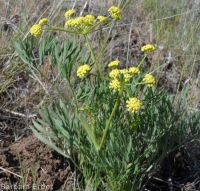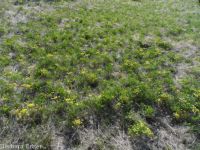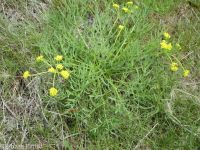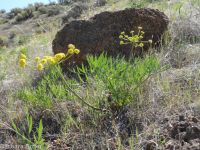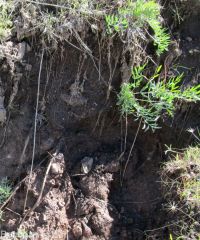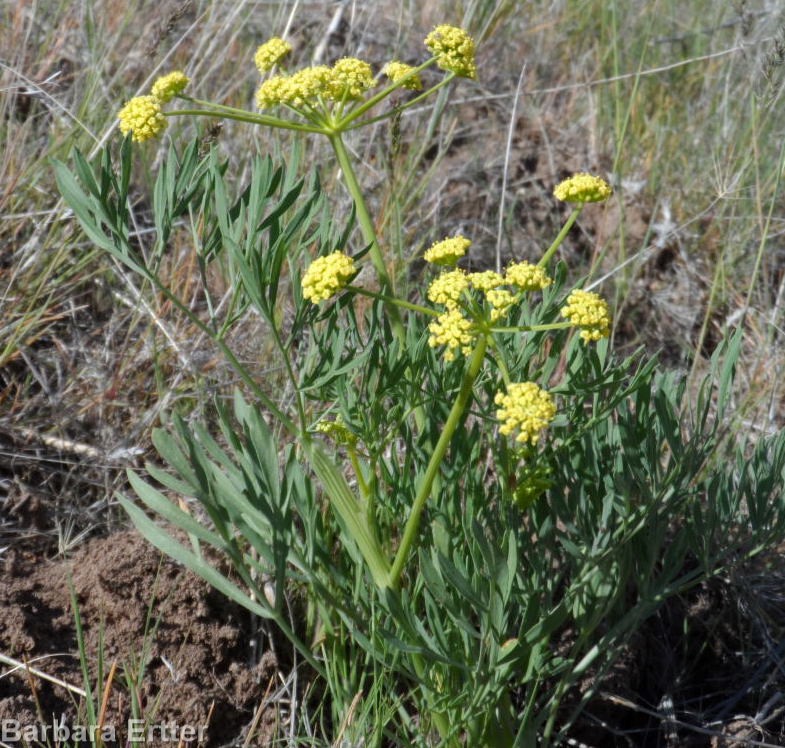
Andrus’s biscuitroot (Lomatium andrusianum) is a recently recognized species that only occurs in the hills north of the Snake River Plains, from Gem to Blaine counties. Within this range it grows primarily on heavy clay soils, especially those derived from rhyolitic substrates, in contrast to the sandier soils preferred by the superficially similar narrowleaf biscuitroot (Lomatium simplex). Plants are often locally abundant, forming dense patches in the Aldape Heights area (Chief Eagle Eye Reserve, Foothills East Reserve, and adjacent Military Reserve) and the top of Chukar Butte; hillsides on the north side of Horseshoe Bend Hill also used to be colored in yellow swaths before non-native annual grasses took over.
The earliest known collection of Andrus’s biscuitroot was from Gem County in 1934, followed by several collections from Horseshoe Bend Hill in the 1950’s. The first collections from the Boise Front were made in 1972, as separate collections by Carol Prentice and by Barbara Ertter. Most of these early collections were initially shoe-horned into Idaho biscuitroot (Lomatium idahoense), but these and subsequent collections were identified as either Lomatium triternatum var. anomalum or L. ambiguum.
The plants were indeed both anomalous and ambiguous, and the question of exactly what their best placement was remained unanswered until the genus caught the attention of a team of botanists at The College of Idaho and Boise State University. Using a combination of molecular, morphological, and ecological data, and with collaborators at other universities, the team concluded that the plants were neither L. ambiguum nor L. triternatum var. anomalum, but instead an undescribed species that deserved its name own name.
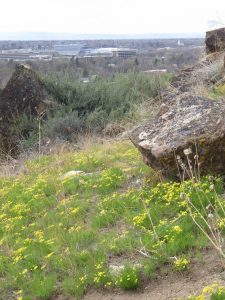
Given the prominence of the new species in the hills overlooking the state’s largest city, and the bottleneck of available funding to continue research on the genus, the team decided to try an innovative fund-raising option that had been used successfully elsewhere: they auctioned off the naming rights for the new species. The winning bid chose to use the opportunity to honor Cecil D. Andrus, former Governor of Idaho and Secretary of the Interior, who passed away in 2017. The new species was formally published as Lomatium andrusianum the following year, with a student member of the team at The College of Idaho, Mckayla Stevens, as the lead author (Stevens et al. 2018).
Andrus’s biscuitroot has been added to Idaho’s rare species list, as S2/S3 (imperiled/vulnerable in Idaho, and globally). This decision is based on the geographically and edaphically restricted distribution in combination with threats from invasive species, development, and general habitat degradation and loss.
Stevens, M., D.H. Mansfield, J.F. Smith, and M.E. Feist. 2018. Resolving the anomaly of Lomatium anomalum: Discovery of a new species in southwestern Idaho (U.S.A.), Lomatium andrusianum (Apiaceae). J. Bot. Res. Inst. Texas 12(1): 1 – 15.
https://symbiota2.math.wisc.edu/pena/portal/taxa/index.php?taxon=250563
